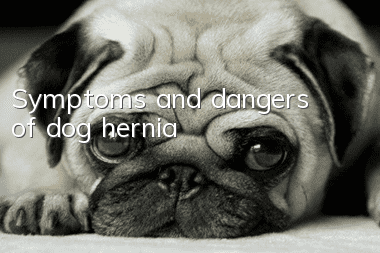Symptoms and dangers of dog hernia

The main clinical symptoms of dog hernia are: abdominal masses, abdominal pain and other symptoms may appear in various parts of the body. After a dog has a hernia, the normal tissues of the body will leak into the hernia hole. If this happens in the long term, it will cause necrosis of some tissues in the dog. If a hernia occurs in the dog’s abdomen, it is very likely to cause intestinal obstruction or intestinal necrosis to the dog. It is recommended that the owner take the dog to the pet hospital for surgery in time to suture the dog's hernia hole.
Dogs suffer from hernia diseases, and the symptoms and harm they show are also related to the location of the hernia.
1.Hiatal hernia
When a dog suffers from a hiatal hernia, the contents of the hernia are usually organs in the abdominal cavity, such as the stomach, intestines, etc. Since a large amount of the hernia contents compress the dog's esophagus and trachea, it will cause obvious vomiting, Shortness of breath.
2. Perineal hernia
If a dog's hernia occurs in the perineal area, it may cause the dog to have difficulty defecating. If the content of the hernia is the bladder, it may also cause the dog to be unable to urinate.
3. Umbilical hernia
Umbilical hernia is located at the belly button of the dog. It mostly occurs in puppies under five months of age. It looks like a localized protrusion. It is soft to the touch, has a wavy feeling, is painless and heatless, and can be recovered by pressing, but will return to its original state after letting go. . It usually causes harm to dogs such as vomiting, loss of appetite, increased body temperature, and pain when touching the affected area. In addition, intestinal gas or constipation may occur. Changing the body position or applying pressure with hands cannot make the swelling disappear.
4. Inguinal hernia
Inguinal hernia is more common in female dogs between 2 and 6 months old. A swollen mass can be seen in the groin. In the later stages of the disease, the swelling will gradually increase in size and harden. It may cause abdominal pain, vomiting or difficulty in defecation in dogs.
- Symptoms of Rheumatism in Dogs What conditions can cause rheumatism in dogs?
- What are the reasons why dogs are obese? Do you know these four reasons?
- Symptoms of protein deficiency in dogs How to supplement protein
- How to treat pica in dogs? Have you seen your dog eating randomly?
- Why do dogs need their nails trimmed? Do you trim your dog’s nails?
- What are the uses of probiotics? What should you pay attention to when feeding your dog probiotics?
- How long does it take for a dog to die from heat stroke? How many hours does it take for a dog to die from heat stroke?
- Differences between Shiba Inu and Akita Inu. Pay attention to these points and it’s super easy to tell the difference!
- What are the reasons for dogs’ gastrointestinal problems? Dogs must be fed regularly
- How to treat urticaria in dogs Symptoms of urticaria in dogs



